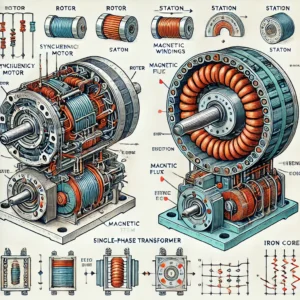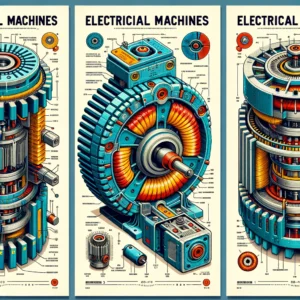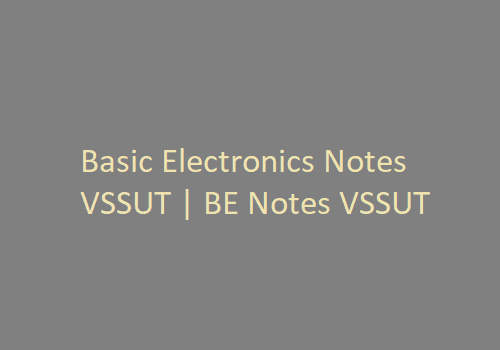Here you can download the free lecture Notes of Electrical Machines 1 Pdf Notes – EM 1 Pdf Notes materials with multiple file links to download. The Electrical Machines 1 Notes Pdf – EM 1 Notes Pdf book starts with the topics covering Electromechanical Energy conversion, Construction & Operation, Generator: Armature reaction, separately excited and self excited generators, Load characteristics of shunt, Principle of operation, Speed control of d .c. Motors, Testing of d .c. machines: Losses, Etc.

Electrical Machines 1 Notes Pdf – EM 1 Notes Pdf
Latest Material Links
Complete Notes
Link – Complete Notes
Unit 1
Link – Unit 1 Notes
Unit 2
Link – Unit 2 Notes
Unit 3
Link – Unit 3 Notes
Unit 4
Link – Unit 4 Notes
Unit 5
Link – Unit 5 Notes
Old Material Links
Complete Notes
Link: Complete Notes
Unit 1
Link: Unit 1 Notes
Unit 2
Link: Unit 2 Notes
Unit 3
Link: Unit 3 Notes
Unit 4
Link: Unit 4 Notes
Unit 5
Link: Unit 5 Notes
Note :- These notes are according to the r09 Syllabus book of JNTUH. In R13 & R15, 8-units of R09 syllabus are combined into 5-units in r13 syllabus. Click here to check all the JNTU Syllabus books
Overview of EM 1 Notes PDF


Electrical Machines 1 is a core subject in electrical engineering that focuses on the fundamental principles and operations of DC machines, including generators and motors. The EM 1 Notes PDF offers a comprehensive guide for B. Tech students, providing detailed explanations of key concepts such as electromechanical energy conversion, construction, operation, and testing of DC machines. These notes are meticulously designed to align with the JNTU syllabus, covering all essential topics required for both theoretical understanding and practical applications in electrical engineering.
The EM 1 Notes PDF includes a wide range of topics, from the basics of electromechanical energy conversion to advanced topics like speed control, armature reaction, and various methods of testing DC machines. Each unit provides clear and concise explanations, making it easier for students to grasp complex concepts. These notes are an invaluable resource for students preparing for exams and projects, providing a solid foundation in the study of electrical machines.
Topics Covered in Electrical Machines 1 Notes
The EM 1 Notes PDF covers a comprehensive range of topics essential for understanding electrical machines. Below is an in-depth outline of the key topics included in the notes:
UNIT I: Electromechanical Energy Conversion
- Introduction to Electromechanical Energy Conversion: Discusses the fundamental principles of electromechanical energy conversion, including the concepts of force and torque in magnetic field systems. Explores the energy balance equation and its application in magnetic field systems.
- Energy and Force in Magnetic Field Systems: Provides detailed explanations on the determination of magnetic force and co-energy in a singly excited magnetic field system. Discusses the concept of multi-excited magnetic field systems and their significance in electrical engineering.
- Examples and Problem Solving: Includes practical examples and problem-solving exercises to reinforce the understanding of energy conversion in magnetic field systems. These exercises help students apply theoretical knowledge to real-world scenarios.
UNIT II: D.C. Generators – Construction & Operation
- Principle of Operation of D.C. Generators: Explores the basic principles behind the operation of DC generators, including the action of the commutator and its role in converting mechanical energy into electrical energy.
- Constructional Features of D.C. Generators: Discusses the constructional features of DC generators, including armature windings (lap and wave windings) and the use of laminated armatures. Provides an overview of simplex and multiplex windings and their applications.
- E.M.F Equation and Problems: Derives the E.M.F equation for DC generators and provides problems and solutions to help students understand its application in practical scenarios.
- Examples and Applications: Provides examples and applications of DC generators in power generation and industrial applications. Discusses techniques for designing efficient and reliable DC generators.
UNIT III: Armature Reaction in D.C. Generators
- Armature Reaction: Examines the concept of armature reaction in DC generators, including cross magnetizing and de-magnetizing effects. Discusses the impact of armature reaction on the performance of DC generators and methods to mitigate its effects.
- Compensating Winding and Commutation: Discusses the role of compensating windings in reducing the effects of armature reaction. Explores the concept of commutation, reactance voltage, and methods for improving commutation in DC generators.
- Examples and Problem Solving: Includes examples and problem-solving exercises on armature reaction and commutation. These exercises help students understand the impact of armature reaction on generator performance and the methods to improve commutation.
UNIT IV: Types of D.C Generators
- Methods of Excitation: Explores different methods of excitation for DC generators, including separately excited and self-excited generators. Discusses the build-up of E.M.F, critical field resistance, and critical speed in DC generators.
- Causes for Failure to Self-Excite and Remedial Measures: Discusses the common causes for failure to self-excite in DC generators and the remedial measures to address these issues.
- Examples and Applications: Provides examples and applications of different types of DC generators in power systems and industrial applications. Discusses techniques for designing and operating efficient DC generators.
UNIT V: Load Characteristics of Generators
- Load Characteristics of Shunt, Series, and Compound Generators: Discusses the load characteristics of different types of DC generators, including shunt, series, and compound generators. Provides detailed explanations of their operating principles and performance characteristics.
- Parallel Operation of D.C Series Generators: Explores the principles of parallel operation of DC series generators, including the use of equalizer bars and cross-connection of field windings. Discusses load sharing techniques for efficient operation.
- Examples and Problem Solving: Includes examples and problem-solving exercises on load characteristics and parallel operation of DC generators. These exercises help students understand the performance characteristics of different types of DC generators and their applications in power systems.
UNIT VI: D.C. Motors
- Principle of Operation of D.C Motors: Provides a detailed explanation of the principle of operation of DC motors, including the concept of back E.M.F and torque equation. Discusses the characteristics and applications of shunt, series, and compound motors.
- Armature Reaction and Commutation in D.C Motors: Examines the impact of armature reaction and commutation on the performance of DC motors. Discusses methods for improving commutation and reducing armature reaction effects in DC motors.
- Examples and Applications: Provides examples and applications of DC motors in industrial and commercial applications. Discusses techniques for designing efficient and reliable DC motors.
UNIT VII: Speed Control of D.C. Motors
- Speed Control of D.C. Motors: Explores various methods for controlling the speed of DC motors, including armature voltage control and field flux control methods. Discusses the Ward-Leonard system for speed control of DC motors.
- Principle of 3-Point and 4-Point Starters: Provides an overview of the principles of 3-point and 4-point starters used for starting DC motors. Discusses the protective devices used in DC motor control systems.
- Examples and Problem Solving: Includes examples and problem-solving exercises on speed control methods and starter design for DC motors. These exercises help students understand the principles of speed control and protection in DC motor systems.
UNIT VIII: Testing of D.C. Machines
- Testing of D.C. Machines: Discusses various methods for testing DC machines, including direct, indirect, and regenerative testing methods. Explores different types of tests, such as brake test, Swinburne’s test, Hopkinson’s test, Field’s test, and retardation test.
- Losses and Efficiency Calculation: Examines the types of losses in DC machines, including constant and variable losses. Provides methods for calculating efficiency and determining the condition for maximum efficiency.
- Separation of Stray Losses in D.C. Motor Test: Discusses the methods for separating stray losses in DC motor tests and their significance in determining machine performance.
- Examples and Applications: Provides examples and applications of testing methods in evaluating the performance of DC machines. Discusses techniques for optimizing the efficiency and reliability of DC machines through effective testing.
Download Links for Electrical Machines 1 Notes PDF
To facilitate easy access to study materials, the EM 1 Notes PDF is available for free download. The notes are organized by unit, allowing students to download specific content as needed for targeted study and revision.
Latest Material Links
Complete Notes
Link – Complete Notes
Unit 1
Link – Unit 1 Notes
Unit 2
Link – Unit 2 Notes
Unit 3
Link – Unit 3 Notes
Unit 4
Link – Unit 4 Notes
Unit 5
Link – Unit 5 Notes
Old Material Links
Complete Notes
Unit 1
Unit 2
Unit 3
Unit 4
Unit 5
Benefits of FREE Electrical Machines 1 Handwritten Notes PDF
Comprehensive Coverage: The notes provide thorough coverage of all critical topics required for a deep understanding of electrical machines. They are ideal for students preparing for exams and practical applications in electrical engineering.
Easy to Understand: Handwritten notes that break down complex concepts into simple, easy-to-understand explanations, enhancing student comprehension and retention.
Aligned with JNTU Syllabus: The content is meticulously tailored to align with the JNTU syllabus, ensuring relevance and accuracy in study materials.
Free and Accessible: These notes are available for free download, providing a cost-effective solution for students needing quality study materials without incurring additional costs.
High-Quality Study Material: Curated by experienced facul ty, these notes offer high-quality content and are a reliable resource for exam preparation, making them a trusted tool for academic success.
Frequently Asked Questions (FAQs)
Q1. Where can I download the Electrical Machines 1 Notes PDF?
You can download the notes from the provided links for each unit or the complete set from Smartzworld.
Q2. How to download the EM 1 Notes PDF?
Click on the respective links for each unit or the complete notes to start downloading. The download process is straightforward and user-friendly.
Q3. How many modules are covered in the EM 1 Notes PDF?
The notes cover a total of eight modules, each focusing on a specific aspect of electrical machines as per the JNTU syllabus.
Q4. What topics are covered in the EM 1 Notes PDF?
The notes cover a wide range of topics, including electromechanical energy conversion, DC generators and motors, armature reaction, speed control methods, and testing of DC machines, among others.
Q5. Where can I get the complete EM 1 Handwritten Notes PDF for FREE Download?
You can access the complete set of handwritten notes for free from the download links provided above. These notes are designed to provide a comprehensive understanding of all key concepts in electrical machines.
Q6. How to download EM 1 Handwritten Notes PDF?
Simply click on the link for the complete set or individual unit notes to download the handwritten PDFs. The notes are available in a downloadable PDF format for ease of use.
Q7. How to Download FREE EM 1 Notes PDF?
Follow the links provided for each unit or the complete notes to download the PDFs for free. The notes are readily available for download, making them accessible to all students.
Reference Books for Electrical Machines 1
To supplement the notes, the following reference books are recommended for a more comprehensive understanding of electrical machines:
- Performance and Design of D.C Machines by Clayton & Hancock, BPB Publishers.
- This book provides a thorough study of the performance and design aspects of DC machines, including detailed discussions on design principles and practical applications. It is an essential resource for students and professionals in electrical engineering.
- Electrical Machines by S.K. Bhattacharya.
- This book offers a detailed exploration of electrical machines, covering both theoretical and practical aspects. It is ideal for students seeking a deep understanding of DC and AC machines.
- Electric Machines by I.J. Nagrath & D.P. Kothari, Tata McGraw-Hill Publishers, 3rd edition, 2004.
- This comprehensive book covers the fundamentals of electrical machines, including detailed discussions on DC and AC machines, transformers, and induction motors. It is a valuable resource for students and professionals in electrical engineering.
- Electromechanics – I (D.C. Machines) by S. Kamakshaiah, Hi-Tech Publishers.
- This book provides an in-depth study of DC machines, including topics such as energy conversion, machine design, and control methods. It is an excellent resource for students and professionals in electrical engineering.
Textbooks:
- Electric Machinery by A. E. Fritzgerald, C. Kingsley, and S. Umans, McGraw-Hill Companies, 5th edition.
- This textbook offers a comprehensive study of electric machinery, including both DC and AC machines. It is a must-read for students and professionals seeking a solid foundation in electrical engineering.
- Electrical Machines by P.S. Bimbra, Khanna Publishers.
- This textbook provides a detailed exploration of electrical machines, covering both theoretical and practical aspects. It is ideal for students and professionals in electrical engineering.
Conclusion
For a comprehensive understanding of Electrical Machines 1 and to excel in your B. Tech exams, always choose Smartzworld to download your EM 1 Notes PDF. These notes are designed to provide the knowledge and resources needed to achieve academic success. By covering all essential topics in a structured and detailed manner, the notes ensure that students have a solid foundation in electrical machines concepts and applications. With access to high-quality study materials, students are well-prepared to face both theoretical and practical challenges in their academic and professional careers.
By leveraging the insights and information provided in these notes, students can develop a deep understanding of electrical machines, positioning themselves for success in the rapidly evolving field of electrical engineering. Whether you are preparing for exams, working on projects, or seeking to enhance your knowledge and skills, these notes serve as a valuable resource to support your learning journey.
Follow us on FB – Smartzworld
How useful was this post?
Click on a star to rate it!
Average rating 4.7 / 5. Vote count: 32
No votes so far! Be the first to rate this post.


